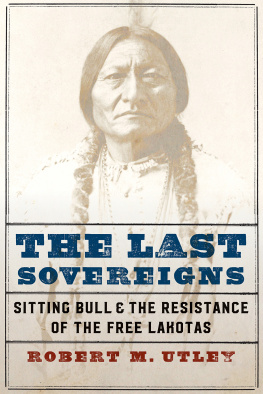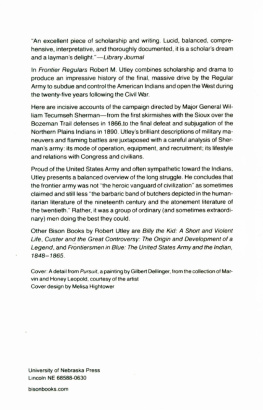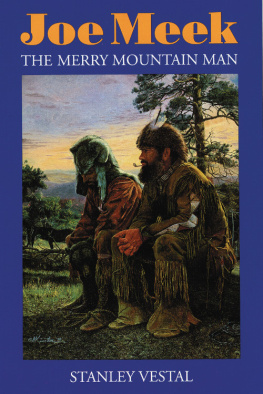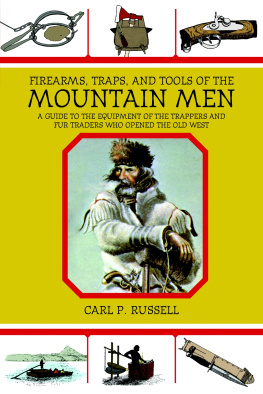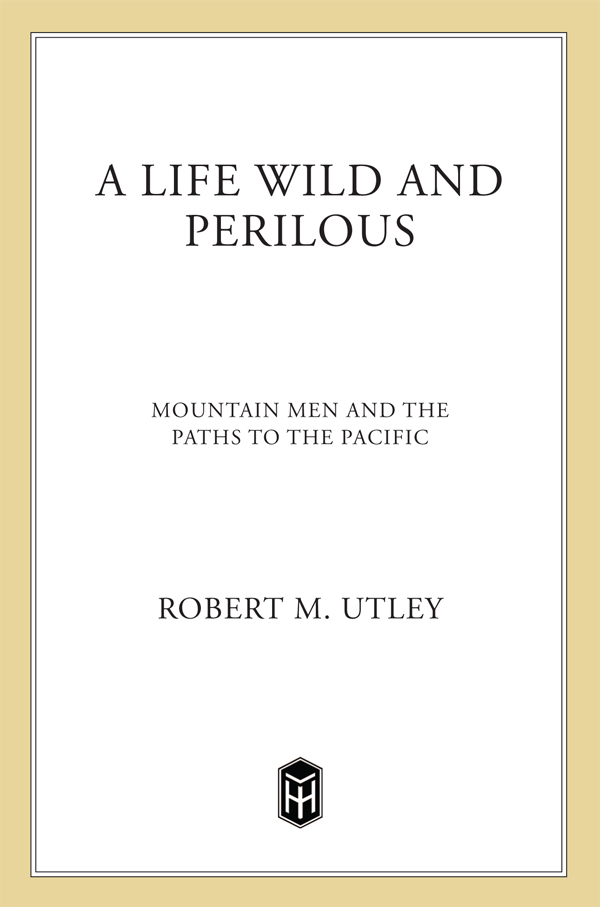Contents
Guide

The author and publisher have provided this e-book to you for your personal use only. You may not make this e-book publicly available in any way. Copyright infringement is against the law. If you believe the copy of this e-book you are reading infringes on the authors copyright, please notify the publisher at: us.macmillanusa.com/piracy.
For Russ Dickenson,
Mountaineer
Chief Ranger, Grand Teton National Park
Director of the National Park Service
Valued colleague and friend.
I defy the annals of chivalry to furnish the record of a life more wild and perilous than that of a Rocky Mountain trapper.
F RANCIS P ARKMAN
F OR A MERICANS , the history of the Trans-Mississippi West dawned with the nineteenth century. The Louisiana Purchase opened fresh vistas beyond a western boundary that traced the course of the mighty river bisecting most of the North American continent. President Thomas Jefferson knew not what he had bought from Napoleon, but he had long been interested in lifting the veil from the western reaches of the continent. Spaniards, Englishmen, Frenchmen, and Russians knew some of the geography, but mainly around the fringes. Indian tribes, their cultures reflecting the immense geographical diversity, knew the heartland. All, in their respective regions, had imprinted human history on the landscape, the Europeans for three centuries, the natives for millennia. For the first half of the nineteenth century, much of the young American republics energies concentrated on discovering and recording the contours of this immense land.
Not alone on revealing the contours. In the fertile mind of Thomas Jefferson himself stirred nebulous visions of a continental destiny for the American people if not for the United States itself. In less than two decades, in the ambitions of an influential segment of national leadership, such musings had hardened into doctrine. Secretary of State John Quincy Adams best expressed it in 1819: The world shall be familiarized with the idea of considering our proper dominion to be the continent of North America, he wrote. Europe shall find it a settled geographic element that the United States and North America are identical. Even more than geographical revelation, therefore, the history of the United States in the first half of the nineteenth century is a saga of national expansiona raucous, relentless, contentious drama, of themes both bright and dark, that deposited the western boundary on the Pacific shore.
In these two great movements of American history, exploration and national expansion, a gathering of colorful and eccentric men numbering less than a thousand at one time played a decisive part. They were the mountain menthe bold adventurers who sought individual freedom and financial reward in the beaver streams of the Rocky Mountains. In their allotted span on the western scene, hardly more than a generation, they came to know the American West as well as the Indians whose trails they followed. What they learned did not remain locked in their minds. It began to seep out in their own time and cascaded forth as their time ran out.
Not only geography but geopolitics benefited from their years of wading in icy mountain streams. Few of the breed would have fully comprehended John Quincy Adamss vaulting declaration, but nearly all were expansionists nonetheless. Some foresaw and actively promoted the continental destiny he declared. Others merely formed part of the tiny vanguard of the westward movement that brought it to fruition. As beaver trappers and fur traders, the mountain men wrote one chapter in the history of the West. As explorers and discoverers, they wrote another. As national expansionists, they wrote still another. This single generation of frontiersmen played a momentous role in the history of the West and in the history of the nation of which it became a part.
The mountain men did not head west for selfless patriotic motives, although forthrightly patriotic nearly all were, nor even for the thrill of unveiling lands unknown to their countrymen, although thrilled some were. They went to make money in a pursuit that promised adventure, excitement, personal freedom, and the nearly total absence of authoritarian restraint. Nonetheless, they were the point men, the advance guard, of a nation unfolding westward, geographically and politically.
This narrative is grounded in the belief that the big themes and their inherent smaller themes are best viewed and understood in the experiences of selected mountain men. Some consciously and personally advanced the process of exploration and expansion. Such were Jedediah Smith, Joseph R. Walker, Ewing Young, Joseph Meek, Thomas Fitzpatrick, and Christopher Carson. Others simply represented a class that collectively and incidentally furthered the process. Such were James Bridger, David Jackson, Old Bill Williams, Pegleg Smith, Black Harris, and Warren Ferris. In the lives of both activist and mere contributor, however, may be glimpsed a significant phase of the process by which the United States became a continental nation. This is their story.
The chapters are not designed as biographies or even minibiographies. Some focus more heavily on a protagonist than others. Some wander far from the man identified in the chapter heading. All aim at showing how a handful of people, acting within a swirl of larger events of which they were mostly unaware, made their contribution to a significant phase of American historythe opening of the West.
Moose, Wyoming, 199296
Georgetown, Texas, 1996
O N M ARCH 9 AND 10, 1804, Captains Meriwether Lewis and William Clark, United States Army, witnessed ceremonies that signaled the onset of their nations expansion beyond the Mississippi River to the Pacific Ocean. The rites took place in St. Louis, the bustling little riverfront community where the flag of Spain flew from a staff in front of the seat of government for Upper Louisiana. Most of the towns citizens were French, still loyal to their heritage forty years after the mother country relinquished her American empire. In a sudden and bewildering sequence of international power plays, however, Spain sold Louisiana back to France, and Napoleon promptly sold it to the fledgling United States.
While a detachment of United States soldiers presented arms, Captain Amos Stoddard officiated on behalf of both France and the United States. On March 9, in front of Government House, the Spanish crowns banner came down and the French republics went up. As a concession to the patriotic sensibilities of the townspeople, Stoddard allowed the tricolor to remain aloft overnight. The next day, near noon, it descended the staff, and the Stars and Stripes was hoisted. Stoddard and the Spanish officials inscribed their signatures on the formal documents of cession. So, as witness, did Captain Lewis. In addition to his commission in the army, he had recently held the post of private secretary to the president of the United States.
The command of Lewis and Clark, already called the Corps of Discovery, lay in winter camp on the east bank of the Mississippi opposite the mouth of the Missouri River. Since November 1803, at dank Camp Dubois, the two captains had filled out their ranks to more than forty men and labored to equip and train them for a journey across the continent.
At Camp Dubois, two members of the Corps of Discovery had already shown singular potential, one for undisciplined rowdyism, the other for staunch dependability. One was a newly enlisted soldier, John Colter, the other a mixed-blood civilian, George Drouillard.


